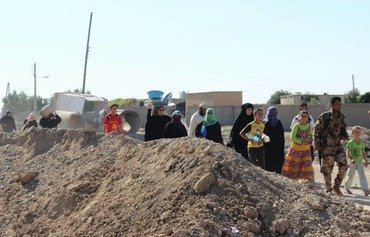As the battle to liberate the Syrian city of al-Raqa draws near, many civilians fear the "Islamic State of Iraq and the Levant" (ISIL) will use them as human shields and are attempting to flee the area, local officials tell Diyaruna.
Residents say ISIL has been tightening its grip on the city since the Syrian Democratic Forces (SDF) launched the operation on November 5th, shutting down Internet cafés, enforcing travel bans and setting up new checkpoints.
Since then, residents say, ISIL has tried to seal the city off from the outside world, imposing a media blackout on the population of more than 300,000.
Those who succeed in escaping al-Raqa are facing a different kind of challenge, with the onset of winter and aid shortages threatening the health of the displaced population sheltering in camps in Ayn Issa and Tel Abyad.
"Internally displaced persons (IDPs) from villages in rural al-Raqa head mainly to Ayn Issa and Tel Abyad through safe humanitarian corridors that the SDF has set up to ensure the safety of civilians fleeing ISIL areas," said SDF unit commander Abdel Fattah Nasreddin.
The process of moving civilians is not easy, he told Diyaruna, as security forces must first ensure ISIL elements will not catch them as they attempt to escape.
Their departure and movement also must be co-ordinated to ensure they are out of the path of airstrikes targeting ISIL, he said, "especially if they are moving in big groups".
Once they reach safe areas, IDPs are searched and their IDs checked to guard against infiltration by ISIL elements looking to escape or carry out suicide bombings against civilians or security forces, Nasreddin said.
They are then moved to temporary camps in Ayn Issa and Tel Abyad near the Turkish border, or the Mabrouka camp near the city of al-Hasakeh, he said.
Relief organisations on alert
Relief organisations in Ayn Issa, Tel Abyad and al-Hasakeh have been mobilised to cope with the anticipated wave of displacement after the start of the operation, said Ocalan Sheikhi, a relief worker at the Turkish-Syrian border.
"However, preparations remain very meagre due to the modesty of available resources and the acute need for international and global support for relief efforts in light of the expected surge in the number of IDPs," he told Diyaruna.
More than 800,000 civilians remain in ISIL-controlled areas and can only escape to Ayn Issa and Tel Abyad, he said, as surrounding areas, such as Deir Ezzor, al-Hasakeh, Palmyra, Hama and the eastern rural areas, are under ISIL or regime control.
Sheikhi estimated that more than "5,000 men, women and children, most of whom are poor or farmers" have been displaced from al-Raqa's northern rural areas since the start of the military campaign.
The Kurdish Red Cross is providing these people with medical care and is working to provide medicine and urgent medical care to the elderly, children and people with chronic diseases, he said.
Meanwhile, the Kobani Organisation for Relief and Development is providing food and basic needs to a large number of IDPs in co-operation with Christian charity group AVC International, he added.
"The biggest challenge facing the IDPs and those involved in the relief efforts is the fact that the new wave of displacement coincides with the advent of winter," Sheikhi said, adding that this will necessitate extra efforts to secure blankets, winter clothes, heating equipment, fuel and medicine.
A farmer's escape
Most people who fled in the early days of the fighting come from villages and farms on the outskirts of northern al-Raqa province, said local farmer Majd al-Jasim, a native of Arikat village in rural al-Raqa who is sheltering in Ayn Issa.
These people "belong to farming communities whose people are entirely dependent on agriculture and animal husbandry", he told Diyaruna.
As the fighting drew near, ISIL elements withdrew from several areas, which gave residents the opportunity to escape to safe areas.
The situation is really dire for the IDPs, al-Jasim said, "especially given the suffering they have endured for months due to the lack of resources, and the fact that some were below the poverty line to begin with".
Some escaped on foot leaving behind their homes and their modest possessions, while others who are slightly better off were able to flee aboard their trucks and agricultural machines taking with them some heads of cattle, he added.
Al-Jasim said he and a number of families from his village and other nearby villages "opted to escape rather than stay and be at the mercy of ISIL elements who would use them as human shields".
The SDF secured a passage for them out of Arikat village, he said, identifying a landmine-free route that also ensured they would not be in the path of airstrikes or be mistaken for ISIL elements infiltrating the area or fleeing al-Raqa.

![Al-Raqa residents flee the 'Islamic State of Iraq and the Levant', heading for the northern towns of Ayn Issa and Tal Abyad on the border with Turkey. [Photo courtesy of the Syrian Democratic Forces]](/cnmi_di/images/2016/11/18/6585-Syria-ISIL-IDP-600_384.jpg)






